Imagine an exploitative fishery...
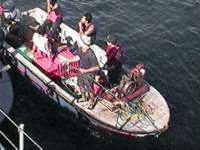 Fleets of dive boats roam the ocean shallows, their divers sweeping the bottom for sea cucumbers,
lobsters, starfish, and any other marine species that could be sold on the international market.
Fleets of dive boats roam the ocean shallows, their divers sweeping the bottom for sea cucumbers,
lobsters, starfish, and any other marine species that could be sold on the international market.
 Stacks of propane bottles, drying racks, processing tanks, camping equipment,
and food are stockpiled in sprawling illegal fishing camps on remote islands
in one of the world's most pristine nature parks.
Stacks of propane bottles, drying racks, processing tanks, camping equipment,
and food are stockpiled in sprawling illegal fishing camps on remote islands
in one of the world's most pristine nature parks.
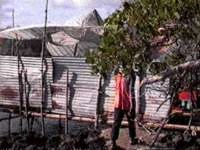 Makeshift huts
hide in mangrove lagoons, where sea cucumbers (pepinos de mar) are
processed for the Asian food market by fishermen who call
themselves "pepineros". Their methods threaten the ecological and
social integrity of these fragile islands
Makeshift huts
hide in mangrove lagoons, where sea cucumbers (pepinos de mar) are
processed for the Asian food market by fishermen who call
themselves "pepineros". Their methods threaten the ecological and
social integrity of these fragile islands
Now Imagine that fishery...
in the Galápagos.
A key moment for conservation
When the President of Ecuador signed the "Special Law for Galapagos" on March 6,1998, the world conservation community joined progressive Galapagos islanders in a great sigh of relief. The law mandated restrictions on exotic species, immigration, and commercial fisheries, further strengthening the protection of this special archipelago that the 19th century naturalist Charles Darwin described as a living laboratory of evolution. Most controversially, the new law expands a ban on industrial fishing from 24 to 64 km around the coastlines of the Galapagos. The ban capped a fractious debate that pitted conservation and ecotourism interests against a powerful commercial fisheries lobby in continental Ecuador.
Why be concerned over fisheries?
Whalers, fur seal hunters, and fishermen have all taken a turn harvesting the marine bounty of the Galapagos since the islands' discovery in 1535. The dizzying wealth of sea life, nurtured by the nutrient-rich upwelling of deep ocean currents as they reach Galapagos, gave the mistaken impression that this wealth was inexhaustible. First whalers, then seal hunters, and now various waves of fishermen have discovered that the islands' marine life is finite.
When boredom with sea rations drove the fishermen ashore, they feasted on tortoise populations so numerous that the shells remaining from the carnage resembled fields of tumbled boulders. The fishermen's inquilines accompanied them onto the fragile islands: 3 species of rats, cockroaches, aggressive stinging ants, a wide variety of spiders, hundreds of aggressive plants, cats, dogs, voracious goats, pigs that snuffle up the eggs of Galapagos' diverse reptile populations, and a myriad of other organisms whose numbers mount in parallel to the explosion in the islands' human population.
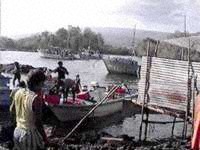 In 1992 on Fernandina, one of the
largest islands of the world which was still free of exotic pests,
and where sea cucumber fishermen had set up uncontrolled camps, a
scientist reported possible sightings of an aggressive predator of
Galapagos fauna, the black rat. This event sparked alarm and
controversy, as ensuing efforts to control the fishermen's
activities stirred up social and political unrest in this normally
peaceful archipelago
In 1992 on Fernandina, one of the
largest islands of the world which was still free of exotic pests,
and where sea cucumber fishermen had set up uncontrolled camps, a
scientist reported possible sightings of an aggressive predator of
Galapagos fauna, the black rat. This event sparked alarm and
controversy, as ensuing efforts to control the fishermen's
activities stirred up social and political unrest in this normally
peaceful archipelago
This site.
This site documents first-hand experiences and views of the troubled period in Galapagos from 1992-1996. It serves to remind us of how vigilant we must be, if the treasured natural wonders of the world are to endure.
Historical perspective.
The creation of Galapagos National Park and the Charles Darwin Foundation's Research Station in 1959 marked a positive turning point in Galapagos conservation history. Approximately 97% of the land mass of Galapagos was included in the National Park, although significant portions of this area had been strongly modified by human activities. Intensive scientific research guided the Park's diligent efforts to control noxious exotic organisms and to rehabilitate populations of Galapagos' unique native animals and plants through captive breeding and other protection programs. A succession of Park management plans, crafted by national and international experts, strove to permit human access to the Park for conservation, research, and tourism, while controlling exploitation of biological and mineral resources.
In the 1980's and early 1990's, the capacity to manage development in Galapagos was outstripped by explosive growth of tourism to the islands. Increased tourism brought successive waves of new immigrants to service the tourism industry, many of them with experience as fishermen or as laborers on boats. With the decline in yield of fisheries worldwide, it was only a matter of time until the marine wealth of Galapagos would be rediscovered.
Timing is everything...
Three principal factors set the stage for increased commercial fisheries in Galapagos in the early 1990's:- Daily air flights carried tourists and provisions to the islands, returning
to the continent with much available, but expensive, cargo space. High-value
seafoods could now reach the continent quickly.
- Local banking and increased money flow accompanied improved communications
with the continent, facilitating efforts to market Galapagos' marine products.
- Depletion of fisheries resources on coastal South America in the 1980's and 1990's sent scores of savvy continental entrepreneurs scurrying to seek their fortune in Galapagos. Striking at a historic moment when various goverment institutions were jockeying for control of Galapagos' coastal waters, the entrepreneurs literally set up camp in the seldom patrolled "wild west" of the islands, along the Bolivar Channel.
First reports.
Responding to reports by scientists at a remote field site, in June, 1992 a research expedition searched the shorelines of Fernandina island along the Bolivar Channel in the western Galapagos for evidence of invasion by the black rat (Rattus rattus)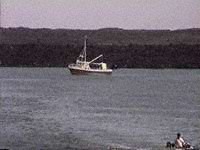 No black rats were found, but the expedition
discovered intense activity by sea cucumber fishermen who were
camped without permission on land in very sensitive, restricted
areas of Galapagos National Park. Garbage and human wastes littered
abandoned campsites in this formerly pristine volcanic
No black rats were found, but the expedition
discovered intense activity by sea cucumber fishermen who were
camped without permission on land in very sensitive, restricted
areas of Galapagos National Park. Garbage and human wastes littered
abandoned campsites in this formerly pristine volcanic
 Researchers informed the authorities of the location of fishermen's camps on
Fernandina and Isabela islands.
Researchers informed the authorities of the location of fishermen's camps on
Fernandina and Isabela islands.
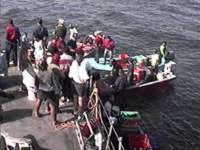 Headed by National Park
authorities, a second expedition set out on the Ecuadorian Armada
gun ship "27 de febrero" to investigate. Journalist Freddy Ehlers,
originator of the popular Ecuadorian TV weekly "La Television",
accompanied the expedition. His powerful documentary on the
activities of the "pepineros" in Galapagos National Park would soon
shock the nation, which thought of the islands as
inviolate.
Headed by National Park
authorities, a second expedition set out on the Ecuadorian Armada
gun ship "27 de febrero" to investigate. Journalist Freddy Ehlers,
originator of the popular Ecuadorian TV weekly "La Television",
accompanied the expedition. His powerful documentary on the
activities of the "pepineros" in Galapagos National Park would soon
shock the nation, which thought of the islands as
inviolate.
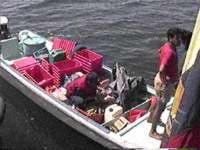 As the expedition
sailed up Bolivar Channel, the calm marine landscape was suddenly
rent by the frothing scream of a "fibra". This high-powered
fiberglass boat was ferrying supplies from the only town on
Isabela, Puerto Villamil, to a remote "pepinero" camp. The
Ecuadorian Marines raced to capture the boat for
inspection.
As the expedition
sailed up Bolivar Channel, the calm marine landscape was suddenly
rent by the frothing scream of a "fibra". This high-powered
fiberglass boat was ferrying supplies from the only town on
Isabela, Puerto Villamil, to a remote "pepinero" camp. The
Ecuadorian Marines raced to capture the boat for
inspection.
The crew had no life jackets, no water supply, no permit from the Armada to enter these waters, and no protection in case the small boat had capsized in the frequently rough waters of Bolivar Channel. No thought had been given to the well- being of the young crew.
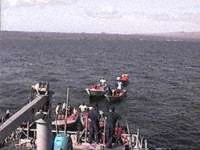 As the "27 de febrero"
proceeded north up Bolivar Channel, scores of white specks came
into view, each a dive boat hunting the shallows for sea cucumbers.
The Marines summoned them to the gun boat for inspection, looking
concerned when they realized that they were out- numbered by
"pepineros" at least 3 to 1.
As the "27 de febrero"
proceeded north up Bolivar Channel, scores of white specks came
into view, each a dive boat hunting the shallows for sea cucumbers.
The Marines summoned them to the gun boat for inspection, looking
concerned when they realized that they were out- numbered by
"pepineros" at least 3 to 1.
 The divers were
poorly equipped, wearing only remnants of poorly fitting neoprene
dive suits. They had only a paint compressor to supply their air
underwater, thus risking serious lung disease from the greasy,
unfiltered compressed air. Several of the divers displayed symptoms
of the "bends" (nitrogen sickness): aching joints, disorientation
and dizziness.
The divers were
poorly equipped, wearing only remnants of poorly fitting neoprene
dive suits. They had only a paint compressor to supply their air
underwater, thus risking serious lung disease from the greasy,
unfiltered compressed air. Several of the divers displayed symptoms
of the "bends" (nitrogen sickness): aching joints, disorientation
and dizziness.
Pepinero camp on Isabela island.
A team including representatives from the Armada, National Park Service, Research Station, and journalist Freddy Ehlers set out to inspect the sea cucumber processing camp on shore.
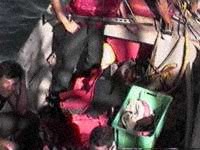 Arriving on Isabela, how would we be received? The marines telegraphed their
concern and uncertainty by keeping their firearms at-the-ready.
Arriving on Isabela, how would we be received? The marines telegraphed their
concern and uncertainty by keeping their firearms at-the-ready.
 Once past the dilapidated "mother"
boats in the narrow bay, the first visible structure was a rickety
hut of tin and poles lashed together over the mangrove roots on the
shoreline.
Once past the dilapidated "mother"
boats in the narrow bay, the first visible structure was a rickety
hut of tin and poles lashed together over the mangrove roots on the
shoreline.
Emanating creaks and strange gurgling sounds, the structure resembled, in its construction and peculiarly complex odors, the shanty towns of impoverished coastal communities on the continent. A light breeze suddenly disentangled the unmistakable odors of sweat, boiling sea cucumbers, and partially combusted gas.
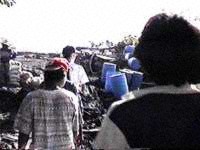 We asked the fishermen for a
tour. They obliged, scarely masking the pride in their
accomplishment. In just 3 days, they had erected a bustling base
camp for some 50 fishermen and assistants, including sea cucumber
processors, stove operators, carpenters to make and repair drying
racks for the sea cucumbers, boat handlers, and even women and
youths who prepared food and attended to the needs of all.
We asked the fishermen for a
tour. They obliged, scarely masking the pride in their
accomplishment. In just 3 days, they had erected a bustling base
camp for some 50 fishermen and assistants, including sea cucumber
processors, stove operators, carpenters to make and repair drying
racks for the sea cucumbers, boat handlers, and even women and
youths who prepared food and attended to the needs of all.
The fishermen had even written a "Pepinero Song", which Ecuadorians soon heard performed on Freddy Ehlers' "La Television" program. The song described how hard their lives were, "working for the boss who makes all the money", and lamented how their "sisters work like slaves cooking all day for two cents of pay" at the camps.
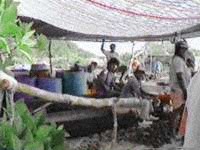 A loose tarpaulin tied to
living mangrove branches shaded the women and youths as they cooked
for the fishermen and processing crew. Simple benches perched atop
stockpiles of propane, bags of rice, sacs of salt, sugar, and other
staples. In such conditions, the introduction of exotic pests to
remote areas of the islands was nearly assured. Most of the people
were not from Galapagos, and seemed unaware of their impact on the
fragile surroundings.
A loose tarpaulin tied to
living mangrove branches shaded the women and youths as they cooked
for the fishermen and processing crew. Simple benches perched atop
stockpiles of propane, bags of rice, sacs of salt, sugar, and other
staples. In such conditions, the introduction of exotic pests to
remote areas of the islands was nearly assured. Most of the people
were not from Galapagos, and seemed unaware of their impact on the
fragile surroundings.
Processing sea cucumbers
Sea cucumbers were harvested from the ocean shallows by divers breathing compressed air. Divers said they could harvest up to 500 sea cucumbers per day, although this would be only in areas of relative abundance and with good visibility in calm waters where the support boats could enter -- conditions which were relatively limited, in the Bolivar Channel. Harvested sea cucumbers spoil easily, so must be processed shortly after collection. Hence, the use of fast boats to expedite processing soon after harvest.
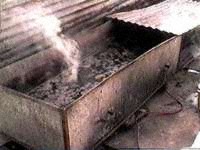 Sea cucumbers are boiled in vats, causing the animals to expel
their gut and any contents. Heat is provided either by gas, as seen here,
or by wood.
Sea cucumbers are boiled in vats, causing the animals to expel
their gut and any contents. Heat is provided either by gas, as seen here,
or by wood.
 Cooked sea
cucumbers are scooped into crates, allowed to drain and
cool.
Cooked sea
cucumbers are scooped into crates, allowed to drain and
cool.
Some "pepineros" cut mangroves to stoke their cooking fires, removing potential nesting sites for the rare Galapagos mangrove finch. Others brought wood from elsewhere to cook the sea cucumbers, raising the threat of introducing wood-infesting insects to remote areas of Galapagos National Park.
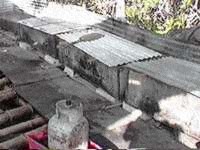 Cooked sea cucumbers were
immersed in hypersaline solution for serveral days to preserve the
tissues. The bamboo floor of this cooking shanty perches
precariously over mangrove roots in a formerly peaceful coastal
lagoon on Isabela island.
Cooked sea cucumbers were
immersed in hypersaline solution for serveral days to preserve the
tissues. The bamboo floor of this cooking shanty perches
precariously over mangrove roots in a formerly peaceful coastal
lagoon on Isabela island.
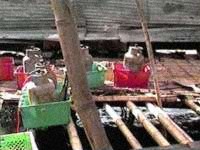 Galapagos sea lions and marine iguanas scatter in surprise when boiling water
from cooking vats or hypersaline pickling water is dumped onto their resting
places among the mangrove roots, below the processing shanty.
Galapagos sea lions and marine iguanas scatter in surprise when boiling water
from cooking vats or hypersaline pickling water is dumped onto their resting
places among the mangrove roots, below the processing shanty.
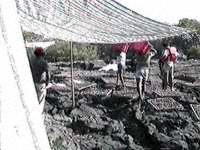 Salt-soaked sea cucumbers are
spread onto drying racks and laid out on the hot, black lava to
dry. Drying takes several days, and if incomplete, the final
product spoils and is not marketable. Workers collect the drying
sea cucumbers at night, shoveling them into plastic barrels to
avoid fog and dew. A surprisingly large proportion of the sea
cucumbers processed in Galapagos were dried inadequately, and so
were wasted.
Salt-soaked sea cucumbers are
spread onto drying racks and laid out on the hot, black lava to
dry. Drying takes several days, and if incomplete, the final
product spoils and is not marketable. Workers collect the drying
sea cucumbers at night, shoveling them into plastic barrels to
avoid fog and dew. A surprisingly large proportion of the sea
cucumbers processed in Galapagos were dried inadequately, and so
were wasted.
Later, in 1994, merchants used the issue of time needed to dry and process sea cucumbers to their advantage, and successfully pressured Fisheries officials into extending the harvest and marketing season after it had been officially closed due to over-harvest. Such decisions created distrust in the management of fisheries, and eventually led to civil unrest.
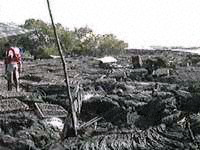 All available
space surrounding the camp is occupied by drying racks. Based on
scientific estimates of the average size and number of sea
cucumbers per drying rack at this time, there are well over 10,000
sea cucumbers in this view. This camp had over 50,000 sea cucumbers
drying on any given day.
All available
space surrounding the camp is occupied by drying racks. Based on
scientific estimates of the average size and number of sea
cucumbers per drying rack at this time, there are well over 10,000
sea cucumbers in this view. This camp had over 50,000 sea cucumbers
drying on any given day.
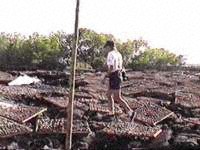 Researcher counts sea
cucumbers on drying racks. This view shows the average number of
sea cucumbers shipped to the continent from this camp every daily
-- approximately 10,000 sea cucumbers.
Researcher counts sea
cucumbers on drying racks. This view shows the average number of
sea cucumbers shipped to the continent from this camp every daily
-- approximately 10,000 sea cucumbers.
Environmental impact?
What was the impact on the marine environment? Sea cucumbers have long been called the "earthworms of the sea" because they perform a function similar to that of earthworms, consuming and grinding materials into finer particles that bacteria can then break down, in the great nutrient cycles of the seas. Elsewhere in the world, over-harvest of sea cucumbers has caused hardening of the sea floor, eliminating habitat for other bottom-dwelling organisms. Recovery may take 50 years or even more. Researchers at the Charles Darwin Research Station and elsewhere are working to better understand these marine systems, just as the islands' conservation and resource managers are working with local fishermen and the national government of Ecuador to protect the coastal waters for future generations. Theirs is a noble enterprise.
Conservation in the Galapagos islands is a work in progress.
We must never forget that.